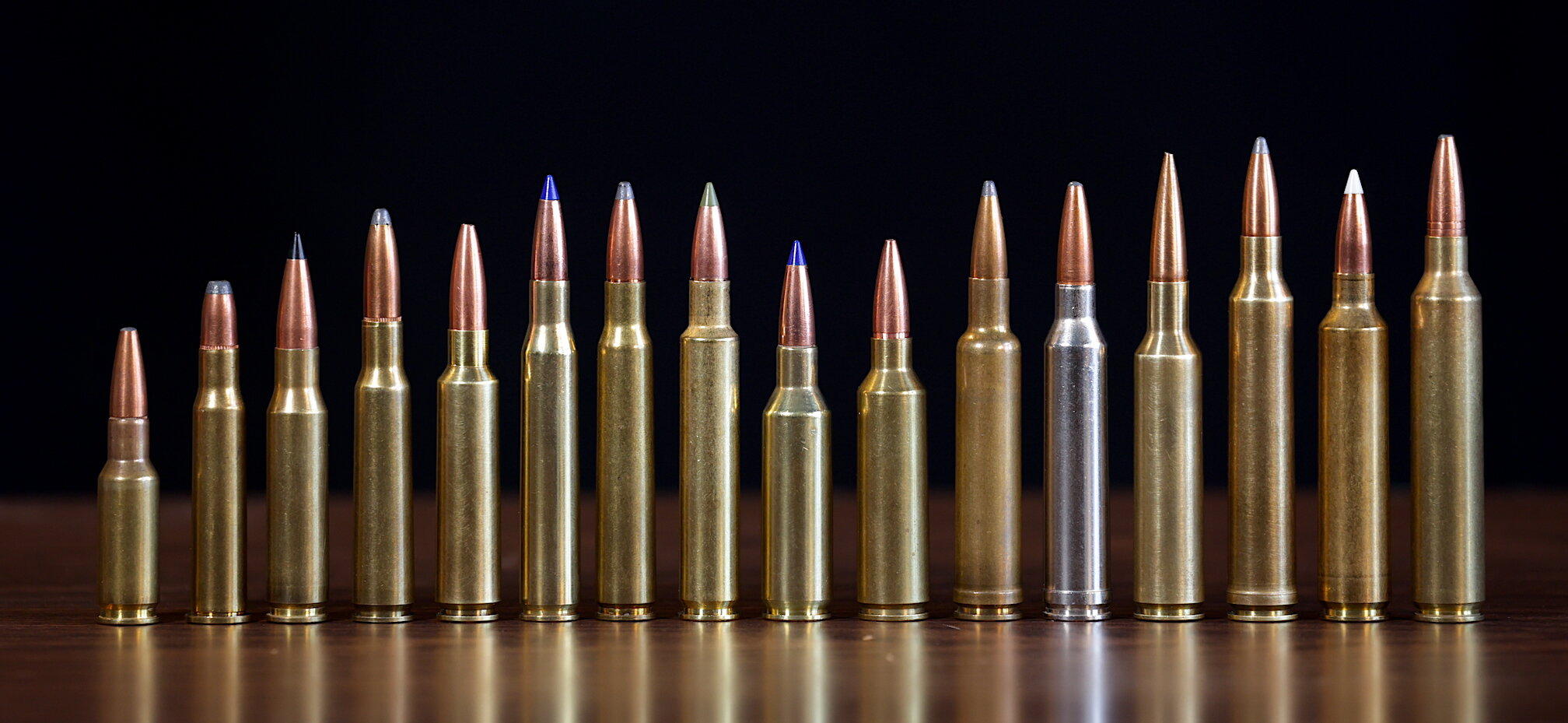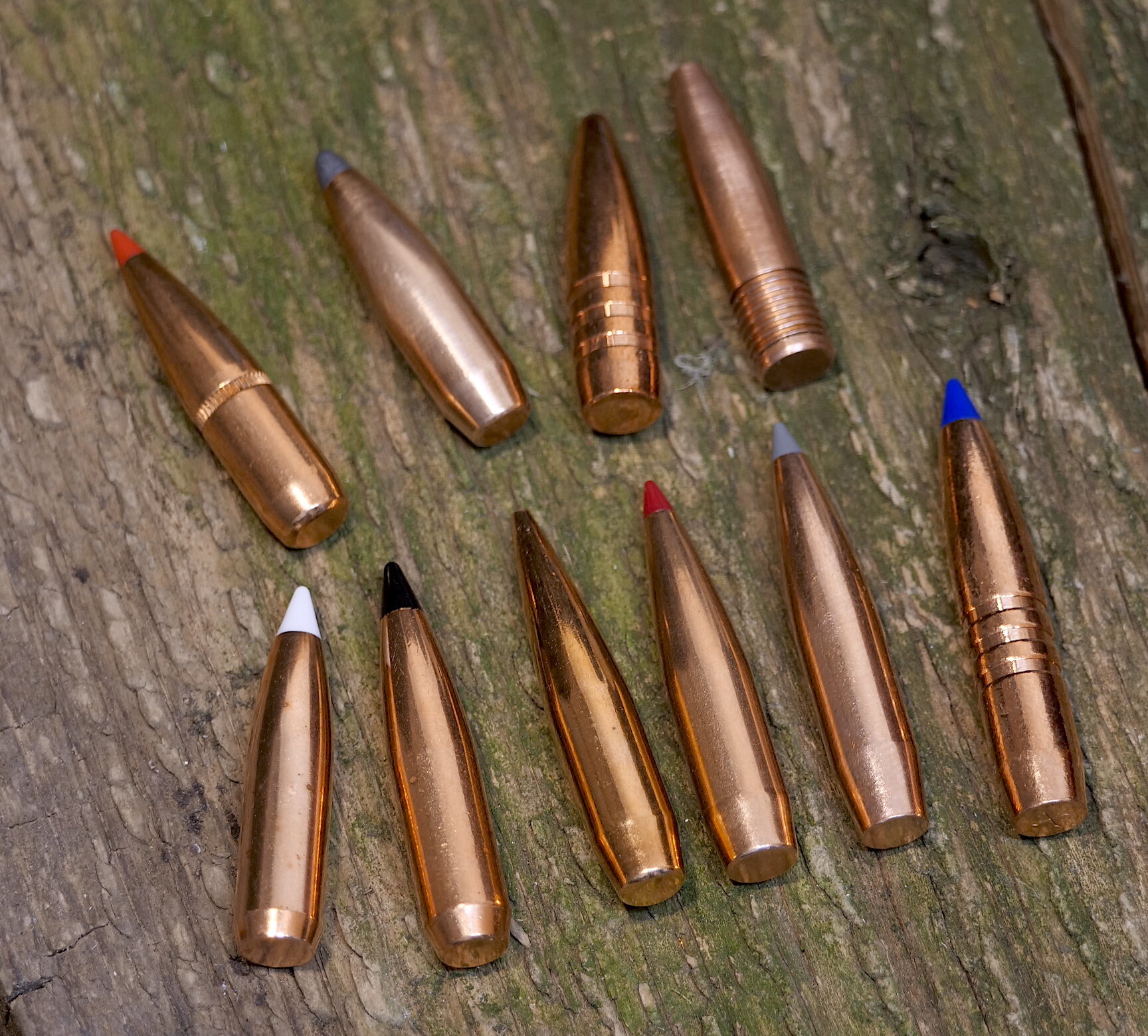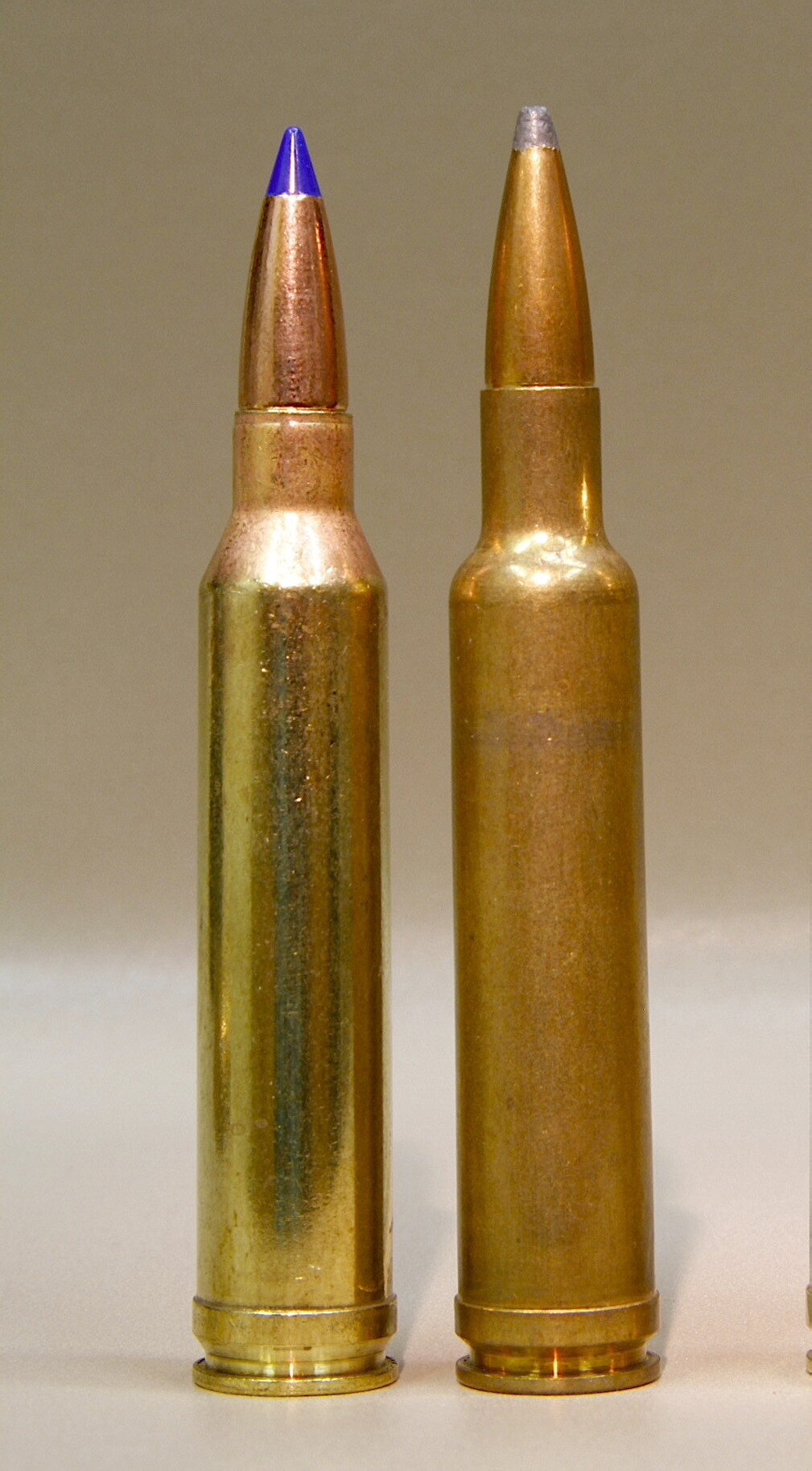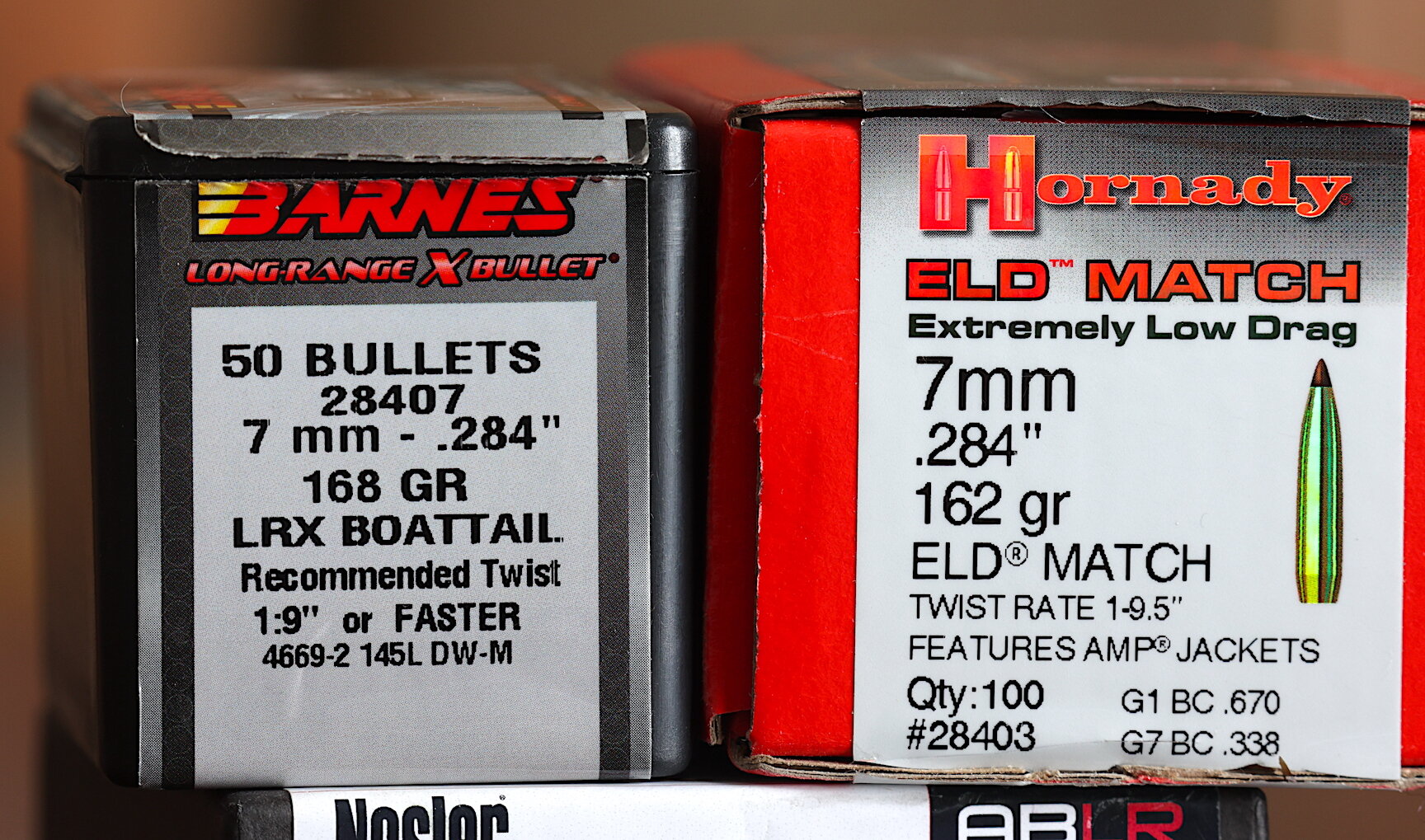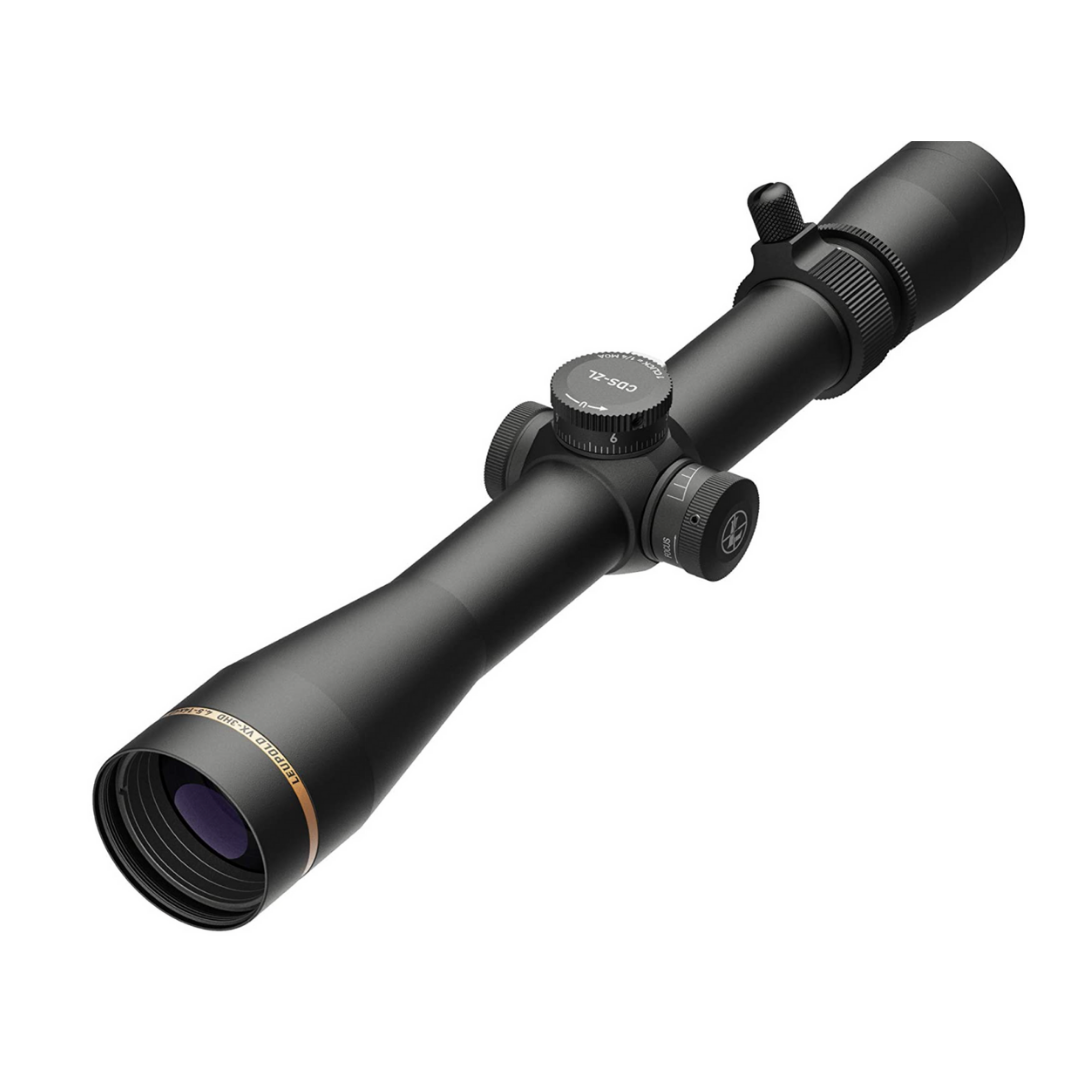7mm Rifle Cartridges: The Sweet Spot
L. to R.: 7mm BR, 7-30 Waters, 7mm-08 Rem., 7x57 Mauser, 284 Win., 280 Rem., 7x64 Brenneke, 280 AI, 7mm SAUM, 7mm WSM, 7mm Wby. Mag., 7mm Rem. Mag., 7mm LRM, 7mm STW, 28 Nosler, 7mm RUM. How fast do you want to go?
The world is awash in 7mm rifle cartridges for a darn good reason: they are perfect.
Perfect is a strong word and of course hyperbolic in this context. The truth is there are no perfect calibers, cartridges, or rifles. Or even bullets, for that matter. But the 7mm bore size comes close. Not so wide that bullets (and thus recoil) become too heavy. Not so narrow that they become ineffective for terminating big game. You can find, load, and shoot high B.C. bullets in the mid- .6s and low .7s that match .308 bullets weighing about 30 grains more.
The Long & Short of 7mm Rifle Cartridges
Of course, long, heavy, high B.C. bullets aren’t mandatory or even desirable for a lot of 7mm shooting and hunting. Here the 7mms also shine. Handloaders can find .284” bullets (the diameter that all 7mm cartridges digest) as light as 100 grains, perfect for pasture rodents, coyotes, and even deer. Mid-size 7mm cartridges like 7x57 Mauser, 7mm-08 Rem., 284 Win., and 280 Rem. make ideal whitetail and mule deer takers with 140-to 160-grain bullets. Elk, moose, kudu and similar large deer and antelope species are best addressed with 160-through 180-grain .284s.
7mm (.284”) bullets come in a wide variety of weights, shapes, and sizes. These don’t include the lightest or largest.
The Short End of the 7mm Stick
The variety in 7mm cartridge sizes is impressive. The little 7mm BR (Bench Rest,) essentially a 308 Winchester shortened to a COAL of just 2.375”, burns about 30 grains of Win 748 powder to push 150-grain bullets about 2,300 fps in rifles, 2,000 fps in the 14” and 15” handgun barrels through which it is most commonly fired.
The 7-30 Waters, a necked down and blown out (wall taper taken out) 30-30 case, was conceived by Ken Waters to improve the ballistics of typical tube magazine lever actions commonly chambered in 30-30. While never hugely popular in that format, the round has become a big hit in T/C Contender pistols where sharply tipped bullets give it a longer reach with reduces wind deflection. Barrels 14” to 15” kick muzzle velocity up to 2,200 fps.
The 7x57 Mauser, aka .275 Rigby, is the Methuselah of 7mms, the first ever. Birth year: 1892. It gained fame first as the “Killer Bee” in Cuba where Spanish troops rained destruction down on U.S. troops shooting 30-40 Krags and 45-70s. This was the impetus for our development of the 30-03 cartridge quickly re-modified to become the 30-06 which is basically a 7x57 Mauser lengthened and necked up for .308 bullets. Sportsmen first started hearing about the Mauser from “Karamojo” Bell, an ivory hunter in Uganda who was averaging 1.5 shots per bull with his .275 Rigby shooting 173- or 175-grain FMJ military bullets. Brain shots primarily, but the occasional heart shot. Bell also dropped kudu, lion, even buffalo with his .275 Rigby. Use enough gun?
Kalahari oryx, also known as gemsbok, are notoriously tough and durable. Betsy’s Jarrett Beanfield Rifle in 7mm-08 Rem. was tougher. Of course, it didn’t hurt that she parked the 140-grain Swift A-Frame high on the shoulder. One shot dropped this spectacular, 41” bull in the sand. PH Hannes Steyn was one of the kindest, most accommodating we’ve ever hunted with. He’s since retired, more’s the pity.
Today’s match for the Mauser is the 7mm-08 Remington, a necked down 308 Winchester that handles considerably more chamber pressures than the Mauser (no ancient rifles to worry about exploding.) Anything the Mauser can or did do, the 7mm-08 can match. It’s a true (Remington size) short-action round and, while not as common as its 308 Win. parent, capable of slightly better long-range ballistics with same weight bullets.
Matching or slightly exceeding the -08 is Winchester’s 1963 quasi-short-action 284 Winchester, a rebated rim case way ahead of its time. Straight sidewalls, 35-degree shoulder, .500” diameter body. The original short-fat. Winchester’s idea was to produce 270 Win. ballistics in a short-action. Its mistake was chambering mainly in its new M100 and M88 auto and lever action rifles. The 284 meets its potential in a precision bolt action where a 22” barrel is sufficient for most hunting applications. Mel Forbes chose the 284 for his showcase, 5-pound M20 sheep rifle. I can vouch for that one! Spectacular performance out to 450 yards on sheep, mountain goats, whitetails, elk and more. The only downside is a shortage of factory loaded ammo. But long range precision shooters are reviving the 284 Win., so stay tuned.
Relative, approximate muzzle velocities of some 7mms pushing 150-grain bullets. These will vary rifle to rifle depending on ammo maker, chamber and bore dimensions, barrel length, temperature, altitude, etc.
Middle Sizes
The German 7x64 Brenneke popped up in 1917. It’s so like the 280 Rem. as to be twins, even though case dimensions are slightly different. Ballistic performance is nearly identical. But ammo is hard to find in much variety. Sadly, the same can be said for the all-American 280 Rem. released in 1957. Like Winchester in ’63, Remington made the mistake of betting its new 28-caliber version of the 30-06 on an autoloading rifle. It reaches full potential in a bolt-action where it can outperform the 270 Win. and many times the 30-06, too. Alas, it’s also largely ignored in factory ammo, but handloaders can make it shine.
An Ackley version of the 280 is becoming the hot new property in 7mms. The 280 AI (Ackley Improved) adds about 100 fps to the 280 Rem. In most AI chambers 280 Rem. ammo can be safely fired, too. The brass flows to the new dimensions and can thereafter be reloaded again and again. Factory rifles and loads are becoming more common each year. This is many shooters’ answer to the 7mm Rem. Mag. without the belt and with slightly less recoil, albeit about 100 fps less MV, too.
Standard 280 Rem. factory loads can usually be fired in 280 AI chambers to create the new brass case for handloading. But it’s easier to buy fully formed 280 AI cases or ammo, both becoming more common. The increased powder volume of the AI case should add 50 to 100 fps to the 280’s speeds plus reduce handloaders’ need to trim case necks.
Riding right with the 7 Rem Mag and AI are the 7mm Remington SAUM (Short Action Ultra Mag) and Winchester WSM (Winchester Short Magnum,) two short-fat cartridges that haven’t done well in the market, but can do anything you need in the field. Expect a 280 AI performance match from the SAUM, a 7mm Rem. Mag. match from the WSM, both in short-action rifles. Factory ammo is scarce and limited, so both these are at their best handloaded.
Most Famous 7mm Rushes In and Inspires Super Magnums
This brings us to the oft-cited 7mm Rem. Mag. After the 7x57, this one put the 7mm on the map. It was a huge hit for Remington beginning in 1962 even though the 7mm Weatherby Magnum had been around since 1944. The Wby. was proprietary. Few hunters were willing to spend the dollars needed for a Weatherby rifle, but the new, inexpensive M700 Remington introduced with the 7mm belted cartridge proved a match made in heaven. Almost overnight it became the most popular 7mm in the U.S. and soon the world. It also pushed the older 280 Rem. deeper into the shadows.
The 7mm Rem. Mag. came 18 years after the round-shouldered Weatherby, but both were formed from the belted 375 H&H case. A bit more internal powder volume gives the Wby. a slight edge in MV, but the Rem. Mag. is more widley available.
A new and rather unknown magnum is Gunwerks 7mm LRM (Long Range Magnum.) It was designed to maximize muzzle velocity with extremely high B.C. bullets in a 30-06 length action. The only manufacturer, to my knowledge, is Gunwerks, so this round should probably fall into the proprietary list, but handloaders might want to consider it.
One centerfire case rarely used for new cartridges was the full-length H&H magnum. This was the parent for most of the Weatherby’s and all of the Winchester and Remington belted magnums, but most of those were shortened to fit 30-06-length actions, keeping access and prices down for average hunters. In 1989 Layne Simpson decided not all hunters wanted 30-06 length actions or needed the lower price option, so he necked down the full-length magnum case for his 7mm STW, Shooting Times Westerner. This adds about 100 fps to the 7mm Rem Mag.
With the STW I imagined the 7mms had reached the top of their ballistic mountain, but Remington proved me wrong in 2001 when it booted its 7mm Remington Ultra Magnum into the fray. This one skips the belted case and goes right to the extra fat 404 Jeffery case for its voluminous powder vault. While the STW burns about 80 grains of some powders to reach top speeds, the RUM burns an additional 8 or 10 grains. Neither handful contributes to long barrel life. But that’s the price of speed.
The 7mm super magnums include the 7mm STW, 28 Nosler, and 7mm RUM. The STW is based on the full-length 375 H&H Magnum case. The other two spring from the fat 404 Jeffery case of 1909, a popular big game round in Africa because it fit bolt-actions rifles costing less than the big side-by-side doubles of the era.
Matching the RUM blow for blow is the Nosler 28, our newest 7mm. Nosler started with that same 404 Jeffery fat case (some say they actually worked with the RUM case, but we won’t nitpick,) but they shortened it enough to squeeze into 30-06 length actions. Figure about 3,300 fps with both pushing 150-grain bullets. They should reach 3,000 to 3,100 fps with 175-grain, maybe a touch more with 28” barrels.
In addition to these 7mms there are at least 18 more from Britain, Europe, and proprietary manufacturers such as Dakota, Lazzeroni, and JDJ plus many wildcats. Only three 7mms have become obsolete, additional proof .284” bullets are effective and popular around the world.
What’s In a Name? Different Numbers, But 7mm Still as Sweet.
Notice that some 7mms are named 28 or 280 or 284. All reference the same bore and bullet diameter. Neither is precisely 7mm nor .280” nor even .284”, but rounded up from slightly narrower dimensions. Measure 7mm land-to-land diameters and you’ll usually come up with .277”. This doesn’t mean you should load .277 bullets. They wouldn’t be wide enough to fill the groove depth of .284”. Even most .284 bullets are a bit narrower than .284. Most I’ve measured come in at .2835” or thereabouts. That’s ok because under the pressure and heat of ignition they obdurate (swell) to fit tightly.
Regardless bullet type or make, all those used in all 7mms are .284”.
Which 7mm Rifle Cartridge is Best for You?
If you’re shopping for one multi-purpose 7mm for deer hunting with the chance for elk, moose, bear and most African plains game, look to the 7mm-08 Remington as your easiest package. The 7x57 Mauser, 284 Winchester, 7x64 Brenneke, and 280 Remington are fine contenders, but none have the factory ammo support. If you handload, which I heartily recommend, you’re set with any. None kick hard in my experience. Shoot lighter bullets and/or download if you’re recoil sensitive.
If you’re confident shooting a bit farther than 300 yards, step up to the 280 AI, 7mm Rem Mag. and Wby Mag., 7 SAUM or 7 WSM. You’ll find the most variety of factory loads in the Rem. Mag.
If you must have the hottest hot rod in the county, look to the STW, RUM, or 28 Nosler. These with high B.C. bullets are your best odds for ringing steel at extreme range. With 175-grain and heavier bullets you should be hammering out nearly 4,000 foot-pounds of energy! And the high Sectional Density (.310) of those long bullets combined with controlled expansion construction should deliver incredibly deep penetration. I’m thinking moose, eland, the biggest bears…
Any hunter struggling to choose between the 6.5mms and 30-calibers should find the best of both worlds in the 7mms. Here’s wishing you success!


